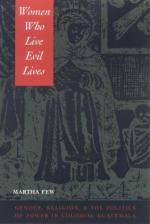|
This section contains 6,826 words (approx. 23 pages at 300 words per page) |

|
There are many ways to approach women's and gender studies in Hinduism. A more-descriptive, less-analytical approach usually deals with the traditional scriptural injunctions relating to women, the concept of strīdharma, feminine archetypes, symbolic structures, divine manifestations, and the ways these matters impact both male and female religious practices and identities. For example, the image of Hindu women (a supposedly homogeneous group essentially different from both Hindu men and non-Hindu women) is often derived from two categories of sacred texts: the Vedas, the oldest and most authoritative Indian texts (c. 1500–600 BCE) and Manusmŗti, the best-known prescriptive text and the most commonly cited source of Hindu dharma (c. second century BCE–second century CE).
Women in the Ancient Texts
The first group of texts confirms that there were women seers in the Vedic age (approximately 1 percent of the hymns of the Ṛgveda are attributed...
|
This section contains 6,826 words (approx. 23 pages at 300 words per page) |

|




